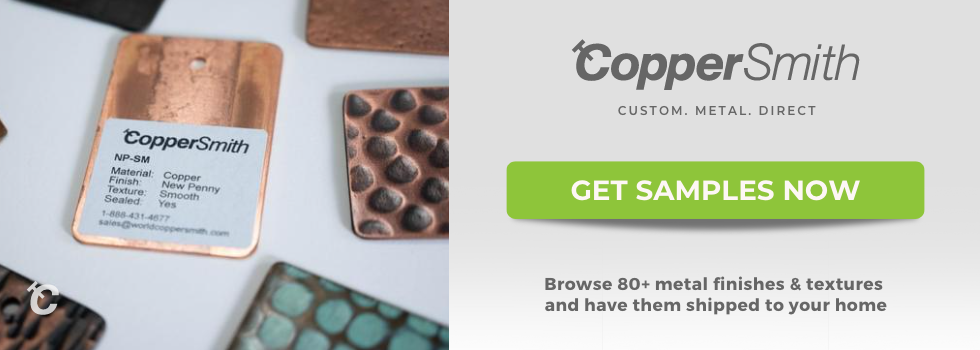
The kitchen sink is one of the dirtiest places in your home. Learn how to keep it clean with these steps, tips, and tricks.
From washing dishes to prepping foods, it’s no wonder that kitchen sinks attract dirt, grease, and grime. Believe it or not, kitchens tend to be one of the dirtiest places in your home. And your kitchen sink is one of the areas that need to be cleaned the most. But it’s easy to forget to routinely clean your sink, assuming it gets cleaned every time the faucet turns on.
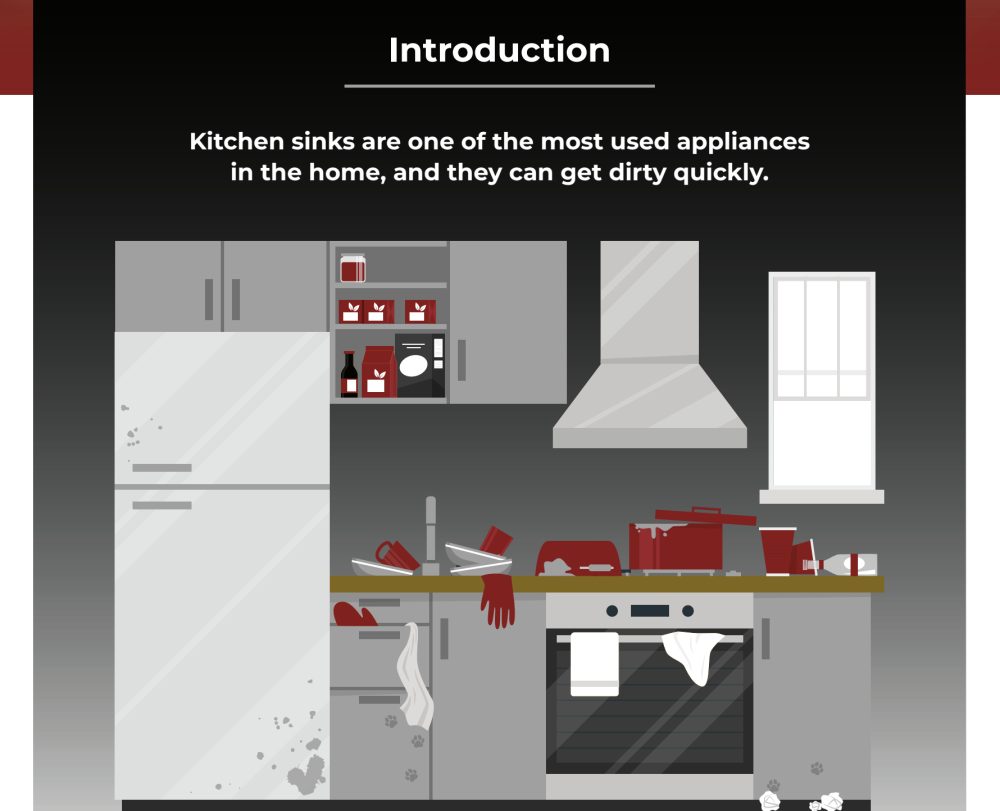
 Frequent cleaning can prevent a build-up of mold and dirt, and help your sink last for years to come. We’ll cover how to clean your kitchen sink, what cleaning supplies to use, special steps to follow for different types of sinks, and daily tips to keep your kitchen sink clean and shiny.
Frequent cleaning can prevent a build-up of mold and dirt, and help your sink last for years to come. We’ll cover how to clean your kitchen sink, what cleaning supplies to use, special steps to follow for different types of sinks, and daily tips to keep your kitchen sink clean and shiny.
6 Steps to Clean Your Kitchen Sink
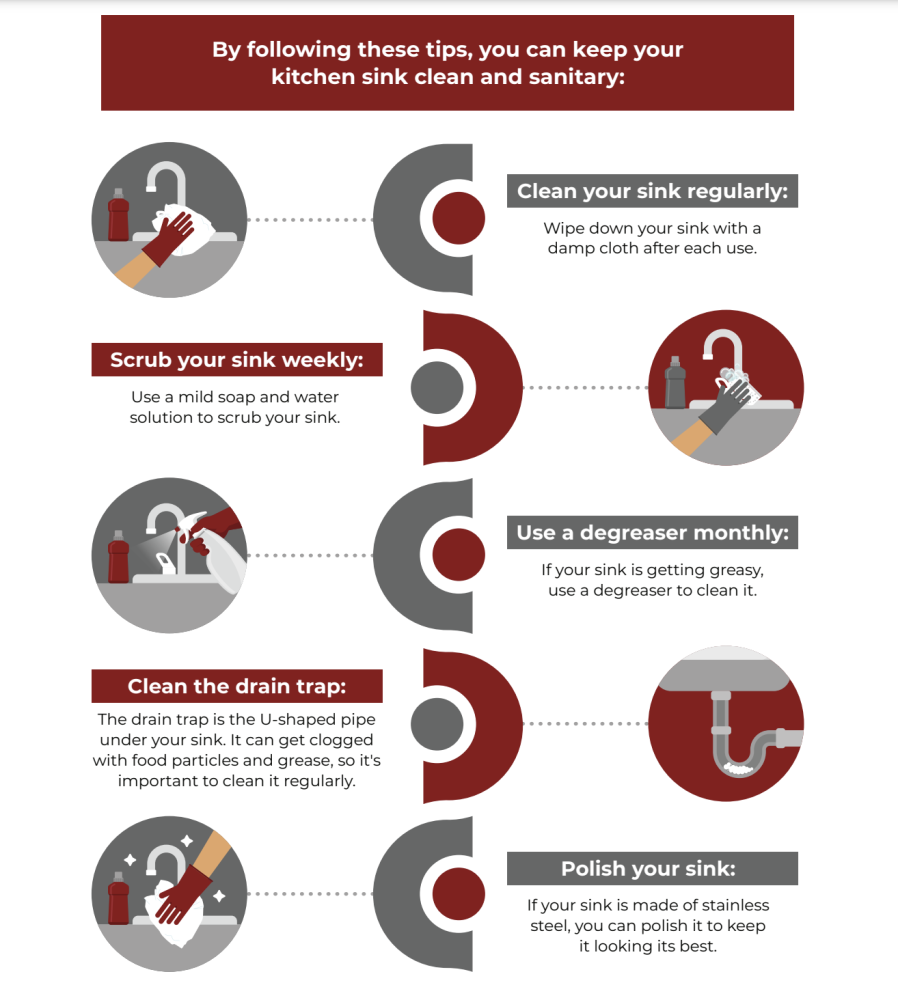
1. Scrub and Rinse Your Sink
First, scrub your sink, including the walls, with mild dish soap and a soft sponge. A mixture of dish soap and warm water is one of the best ways to clean and maintain most sinks. Read on below for specific cleaning solutions for different types of materials like stainless steel, copper, granite composite, and more.
2. Don’t Forget Hard-to-Reach Spaces
It’s easy to overlook your faucet, handles, sink strainers, and other small spaces on your sink. But oftentimes there are food particles or grease trapped in these areas. Use a small sponge or toothbrush to gently scrub along your faucet, drains, and spray nozzles.
3. Disenfect
Now that you’ve scrubbed off any grease and grime in your sink, it’s important to disinfect it and get rid of any germs. For a natural cleaning solution, you can use vinegar and water on most sinks, like stainless steel, but some materials aren’t vinegar-safe. In those cases, you can use hot water and soap to disinfect the surface or a store-bought sink cleaner. To prevent damage, always double-check that any new cleaning solution is safe for your sink’s surface before using it.
4. Clean Any Dish Brushes or Sponges
Don’t forget about any tools that you may have in your sink, such as dish brushes or sponges. Kitchen sponges should be replaced every two weeks to prevent a build-up of bacteria or odors. To help prevent your sponge from getting dirty, remember to clean it with soap after use and squeeze out all water before allowing it to fully dry. Throw your dish brushes and sponge holders in your dishwasher—it’s an easy way for them to get sanitized.
5. Last But Not Least, Your Garbage Disposal
To clean your kitchen sink’s garbage disposal, stop the drain and fill the sink with hot, soapy water. Then, let the soapy water drain. Next, sprinkle a half-cup of baking soda into the opening of the garbage disposal. Pour in a cup of white vinegar and allow it to sit for 10 minutes. Last, turn on the garbage disposal and let the hot water rinse away the baking soda mixture. To deodorize your disposal, add a few slices of orange or lemon peels to keep it smelling fresh.
6. Once You’re Finished Cleaning, Dry Your Sink
Don’t forget to dry your sink once you’re finished rinsing and cleaning. Water and wet environments are breeding grounds for bacteria. Plus, leftover water can cause your sink to dull or develop stains over time. To dry your sink, simply wipe it down with a paper towel or microfiber cloth.
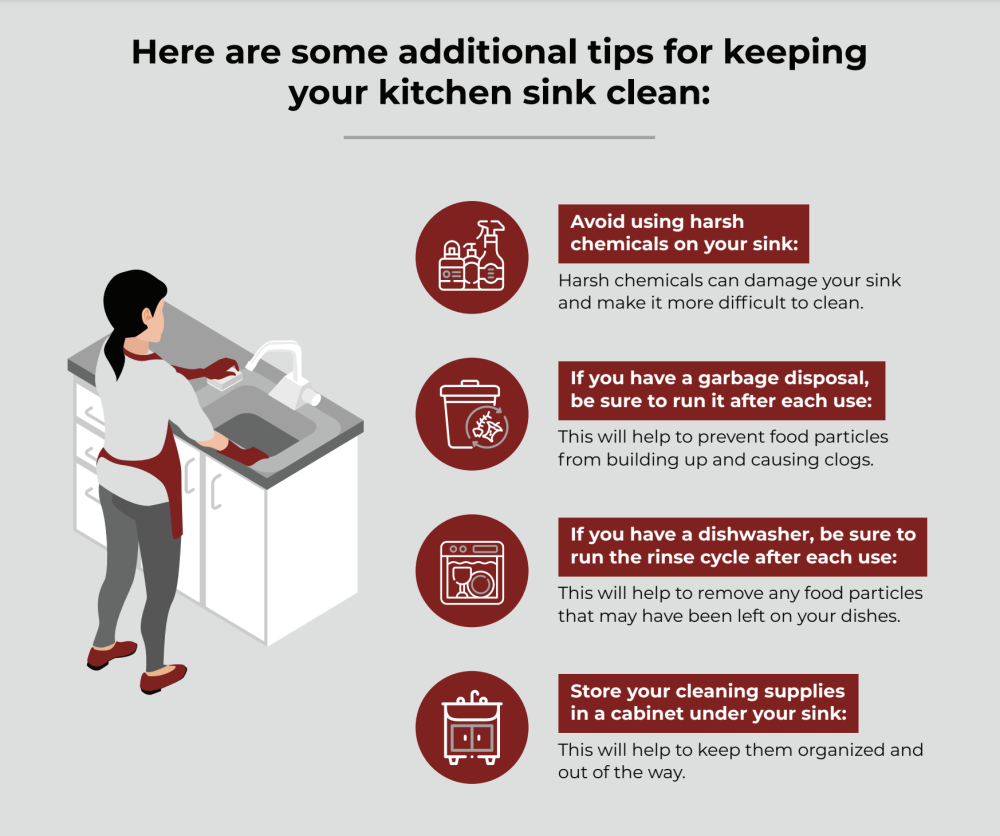
Cleaning Tips and Tricks for Different Sink Materials
Different types of sinks need different cleaning materials. Here’s what you need to know to safely clean your stainless steel, ceramic, granite composite, and copper kitchen sink.
Stainless Steel
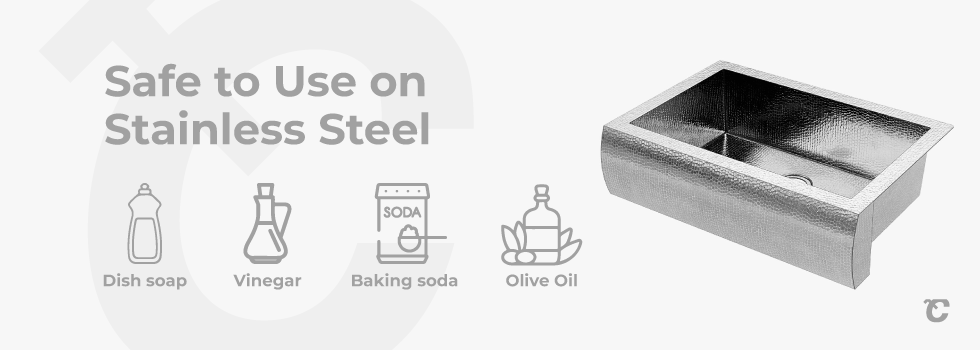
Stainless steel kitchen sinks are the most popular choice because they’re durable and very easy to keep clean. While they’re long-lasting and tough, stainless steel sinks are likely to scratch over time. Always use caution when cleaning your stainless steel sink to prevent scratches or damage, no matter the finish of your sink (brushed, hammered, etc). See below for safe and unsafe cleaning materials to use on stainless steel:
Safe to Use on Stainless Steel
- Dish soap. Use dish soap and warm water for daily cleanings.
- Vinegar is safe to use on stainless steel and will leave the surface sparkling.
- Baking soda. Baking soda and water are a popular mixture to deep clean stainless steel and make it shine.
- Olive oil. Once you’ve cleaned your sink, add a drop of olive oil to a soft microfiber cloth and rub it in.
Not Safe to Use on Stainless Steel
- Abrasive cleaners like Comet aren’t safe to use on stainless steel sinks. This cleaner will scratch the finish of your sink.
- Bleach. Don’t use bleach to clean a stainless steel sink, the chlorine can attack the protective layer on the steel, which is what makes the sink stainless.
- Steel wool. Never use abrasive pads like steel wool on to clean your stainless steel sink because they will scratch the surface.
- Magic Eraser. Even though stainless steel is durable, you can’t use a Magic Eraser on stainless steel because it may scratch the finish of your kitchen sink.
To keep your stainless steel sink clean, and prevent the need for frequent deep cleans, follow these steps:
- Rinse it after every use. Once you’re finished cooking and cleaning, rinse your sink well and make sure no food or residue is left behind.
- Wipe it down. Once you’ve rinsed out your sink, use your sponge and a few drops of dish soap to quickly scrub down your sink. This will help cut down on grease and lingering smells. Make sure you use a soft sponge and nothing with hard edges.
- Dry it with a microfiber cloth. Once you’ve washed away any soap, dry off your sink with a microfiber cloth to help it shine.
Fireclay and Granite Composite Sinks
Similar to stainless steel sinks, the best cleaner to use on fireclay and granite composite sinks is warm water and dish soap. But sometimes that’s not strong enough to get rid of stubborn stains, here are materials safe and not safe to use on fireclay and granite kitchen sinks:
Safe to Use on Fireclay and Granite Composite
- Dish soap. Use dish soap and warm water for daily cleanings.
- Naturally clean deep stains with vinegar. Let the vinegar sit on the stain overnight, then wash away in the morning.
- Baking soda. Create a baking soda solution and gently rub it into your sink with a soft sponge.
- Magic Eraser. You can wipe away water marks and stains with a Magic Eraser.
- Bleach. You can use a 50/50 water/bleach solution on a fireclay sink. Always thoroughly rinse the sink after using bleach.
Not Safe to Use on Fireclay and Granite Composite
- Steel wool. Never rub steel wool on your sink because it can scratch the material’s surface.
- Scouring powders. These cleaners may not be suitable for your sink and could potentially damage the sink’s finish.
Copper Sinks
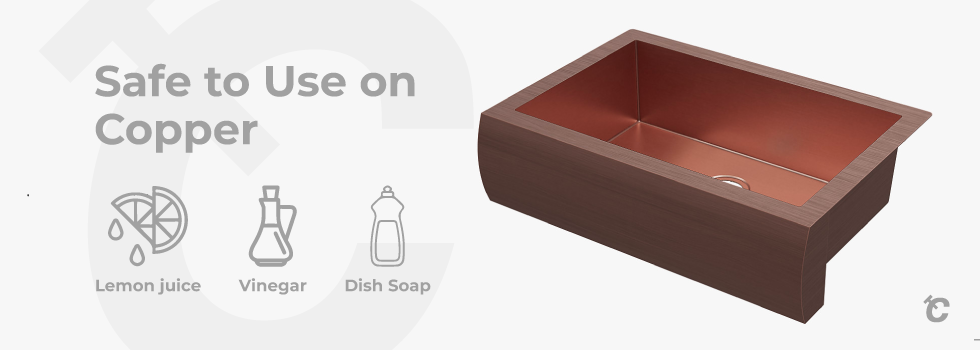
Because copper is a “living” metal, it develops a unique patina over time. Some copper sinks are sealed to prevent patina and maintain their golden, reddish-brown color. To make your copper kitchen sink last, you need to use proper cleaning materials to prevent damage and protect it over time. Read our entire guide on how to clean copper and see below for copper-approved cleaning materials.
Safe to Use on Copper
- Lemon juice. Combine one part salt with two parts lemon juice and create a paste. Spread the paste onto any stains and gently buff it with a soft cloth. Thoroughly rinse the paste off and then dry the area with a soft cloth.
- Vinegar. Sprinkle salt over the copper and pour vinegar over the area. Gently buff the area with a soft cloth, rinse, and pat dry with a cloth.
- Dish soap. Gently clean your copper sink with dish soap and warm water.
Not Safe to Use on Copper
- Bleach. Never use bleach on your copper sink because the corrosive chemicals can react with the metal and leave behind stains.
- Comet. Abrasive cleaners such as Comet can stain your sink and ruin the finish.
- Steel wool. Never use steel wool to clean your copper kitchen sink because it will scratch the metal. Instead, use a soft sponge or cloth.
Kitchen Sink Cleaning Tips and Tricks
Now that you know how to keep your kitchen sink clean, follow these pieces of advice on how often to clean, how to prevent bacteria, and more.
Wash Your Sink at Least Once a Week
To keep bacteria and microorganisms from collecting in your kitchen sink, you should wash and disinfect your sink at least once a week. However, if you’re handling raw meats or poultry in your sink, you should disinfect it with a cleaner. Rinsing the sink with water won’t kill bacteria that may be lingering behind, so make sure you’re following up with soap or a disinfectant.
Rinse and Sanitize Your Sink to Prevent Bacteria
While you may rinse your sink out daily, remember rinsing isn’t the same as sanitizing. To prevent bacteria and germs in your sink, disinfect it weekly with a safe cleaning solution for your kitchen sink. If your sink tolerates it, white vinegar is one of the best ways to naturally disinfect a kitchen sink. However, don’t swap vinegar for your normal dish soap when it comes time to wash your dishes.
Revive a Stainless Steel Sink with Baking Soda
Is your stainless steel sink looking rusty or dull? Choose a cleaner that doesn’t contain bleach, like baking soda or a scrub powder. Gently rub the cleaner into your kitchen sink and buff away any rusty or dull spots. Once you’ve cleaned your sink, buff a small amount of olive oil on the surface with a soft cloth for added shine. Some experts say you can also buff your stainless steel sink with flour to get a sparkling finish. Follow these steps and your stainless steel sink will look almost brand new!
 Never Pour Bleach Down Your Kitchen Sink
Never Pour Bleach Down Your Kitchen Sink
While bleach may sound like a quick fix to clean or unclog your kitchen sink drain, never pour bleach down your kitchen sink. It’s a strong acid that can react with other substances in your pipes. Plus, it can release toxic fumes if it mixes with other household cleaners. To safely clean your garbage disposal, follow our steps above to prevent damaging your sink and pipes.
Follow these tips and tricks to keep your kitchen sink looking as sparkling and new as the day it was installed. If you’re considering replacing your kitchen sink, reach out to our team to learn more about our handcrafted and sustainable sinks. For more cleaning guides and information on kitchen sinks, check out our articles for the latest news and information.



